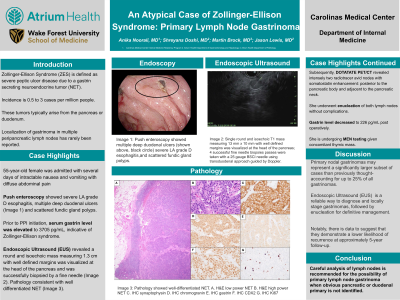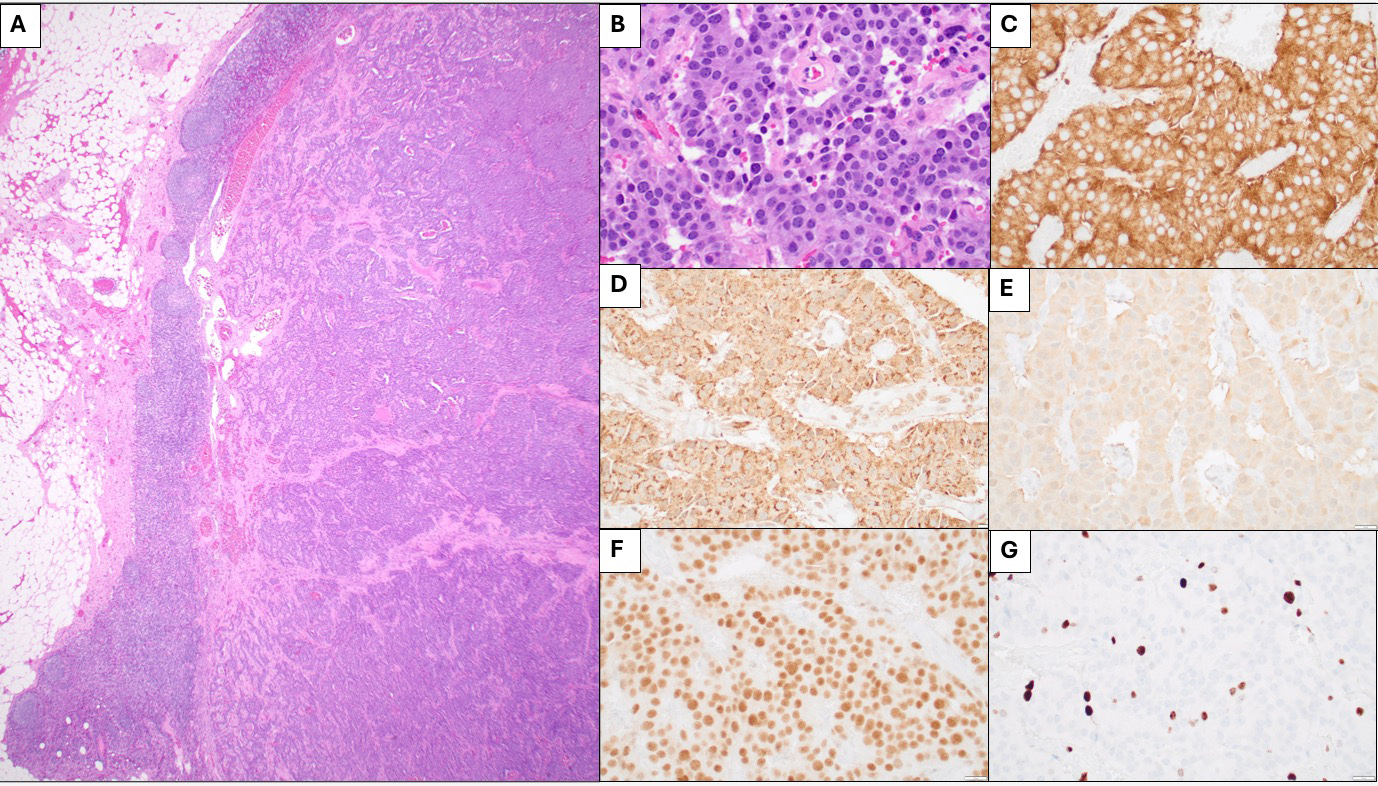Monday Poster Session
Category: Stomach
P3405 - An Atypical Case of Zollinger-Ellison Syndrome: Primary Lymph Node Gastrinoma
Monday, October 28, 2024
10:30 AM - 4:00 PM ET
Location: Exhibit Hall E

Has Audio

Anika Noorali, MD
Atrium Health
Charlotte, NC
Presenting Author(s)
Anika Noorali, MD1, Shreyans Doshi, MD2, Martin Brock, MD1, Jason J. Lewis, MD1
1Atrium Health, Charlotte, NC; 2Wake Forest University School of Medicine, Charlotte, NC
Introduction: Classically presenting with copious diarrhea and intractable vomiting, Zollinger-Ellison Syndrome (ZES) is defined as severe peptic ulcer disease due to gastrin-secreting neuroendocrine tumor (NET). While these tumors typically arise from the pancreas or duodenum, in some rare cases, they can develop in atypical or ectopic locations, including lymph nodes. Localization of gastrinoma in multiple lymph nodes has rarely been reported.
Case Description/Methods: A 55-year-old female presented with several days of intractable nausea and vomiting with upper abdominal pain. Computed Tomography (CT) of the abdomen revealed nonspecific prominence of the proximal small bowel. Broad-spectrum antibiotics were started. Repeat CT after two days showed hyperenhancement of the jejunum, suggesting worsening enteritis. Push enteroscopy showed severe LA grade D esophagitis, multiple deep duodenal ulcers, and scattered fundic gland polyps. Her testing was negative for H pylori, viral cytopathic effect, and fungal organisms. Prior to PPI initiation, serum gastrin level was elevated to 3705 pg/mL, indicative of ZES. Furthermore, endoscopic ultrasound (EUS) revealed an exophytic mass measuring 1.3-centimeters adjacent to the head of the pancreas, which was successfully sampled by a fine needle biopsy. The remainder of the pancreatic parenchyma was normal. Pathology showed well-differentiated NET. DOTATATE PET/CT revealed two radiotracer avid nodes with somatostatin enhancement. During her diagnostic laparoscopy, a 2.0-centimeter node was localized between the posterior stomach wall and the pancreas. A second 2.0-centimeter lymph node was found anteriorly to the left gastric artery. She underwent enucleation of both lymph nodes without complications. Gastrin level was 226 pg/mL postoperatively. Given concern for thymic carcinoma, evaluation of mediastinal mass is on-going and subsequent genetic testing for MEN1 syndrome.
Discussion: Primary nodal gastrinomas may represent a significantly larger subset of cases than previously thought- accounting for up to 25% of all gastrinomas. EUS is a reliable way to diagnose and locally stage gastrinomas, followed by enucleation for definitive management. Notably, they demonstrate a lower likelihood of recurrence at approximately 5-year follow-up. Genetic testing for MEN1 syndrome should be encouraged with gastrinoma diagnosis and concomitant thymic carcinoma. When ZES is considered, careful analysis of lymph nodes is recommended for the possibility of primary lymph node gastrinoma.

Disclosures:
Anika Noorali, MD1, Shreyans Doshi, MD2, Martin Brock, MD1, Jason J. Lewis, MD1. P3405 - An Atypical Case of Zollinger-Ellison Syndrome: Primary Lymph Node Gastrinoma, ACG 2024 Annual Scientific Meeting Abstracts. Philadelphia, PA: American College of Gastroenterology.
1Atrium Health, Charlotte, NC; 2Wake Forest University School of Medicine, Charlotte, NC
Introduction: Classically presenting with copious diarrhea and intractable vomiting, Zollinger-Ellison Syndrome (ZES) is defined as severe peptic ulcer disease due to gastrin-secreting neuroendocrine tumor (NET). While these tumors typically arise from the pancreas or duodenum, in some rare cases, they can develop in atypical or ectopic locations, including lymph nodes. Localization of gastrinoma in multiple lymph nodes has rarely been reported.
Case Description/Methods: A 55-year-old female presented with several days of intractable nausea and vomiting with upper abdominal pain. Computed Tomography (CT) of the abdomen revealed nonspecific prominence of the proximal small bowel. Broad-spectrum antibiotics were started. Repeat CT after two days showed hyperenhancement of the jejunum, suggesting worsening enteritis. Push enteroscopy showed severe LA grade D esophagitis, multiple deep duodenal ulcers, and scattered fundic gland polyps. Her testing was negative for H pylori, viral cytopathic effect, and fungal organisms. Prior to PPI initiation, serum gastrin level was elevated to 3705 pg/mL, indicative of ZES. Furthermore, endoscopic ultrasound (EUS) revealed an exophytic mass measuring 1.3-centimeters adjacent to the head of the pancreas, which was successfully sampled by a fine needle biopsy. The remainder of the pancreatic parenchyma was normal. Pathology showed well-differentiated NET. DOTATATE PET/CT revealed two radiotracer avid nodes with somatostatin enhancement. During her diagnostic laparoscopy, a 2.0-centimeter node was localized between the posterior stomach wall and the pancreas. A second 2.0-centimeter lymph node was found anteriorly to the left gastric artery. She underwent enucleation of both lymph nodes without complications. Gastrin level was 226 pg/mL postoperatively. Given concern for thymic carcinoma, evaluation of mediastinal mass is on-going and subsequent genetic testing for MEN1 syndrome.
Discussion: Primary nodal gastrinomas may represent a significantly larger subset of cases than previously thought- accounting for up to 25% of all gastrinomas. EUS is a reliable way to diagnose and locally stage gastrinomas, followed by enucleation for definitive management. Notably, they demonstrate a lower likelihood of recurrence at approximately 5-year follow-up. Genetic testing for MEN1 syndrome should be encouraged with gastrinoma diagnosis and concomitant thymic carcinoma. When ZES is considered, careful analysis of lymph nodes is recommended for the possibility of primary lymph node gastrinoma.

Figure: A. H&E low power NET B. H&E high power NET C. IHC synaptophysin D. IHC chromogranin E. IHC gastrin F. IHC CDX2 G. IHC Ki67
Disclosures:
Anika Noorali indicated no relevant financial relationships.
Shreyans Doshi indicated no relevant financial relationships.
Martin Brock indicated no relevant financial relationships.
Jason Lewis indicated no relevant financial relationships.
Anika Noorali, MD1, Shreyans Doshi, MD2, Martin Brock, MD1, Jason J. Lewis, MD1. P3405 - An Atypical Case of Zollinger-Ellison Syndrome: Primary Lymph Node Gastrinoma, ACG 2024 Annual Scientific Meeting Abstracts. Philadelphia, PA: American College of Gastroenterology.
